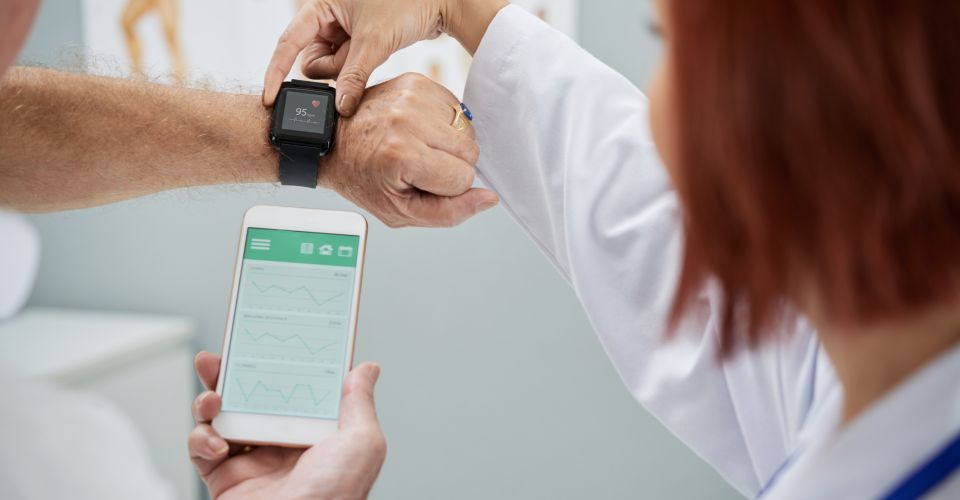The power of technology – Conversis’ Patient Centricity series

If you haven’t read article 1 – “A trial is nothing without a patient”, we’d suggest you start there and then come back to this one. Article 1 dives into the topic of patient centricity; what it means and how it’s being implemented in the real world. It’s a good introduction to the subject in general, before drilling down into specific techniques and approaches, as we’re doing here with technology.
If you’re mostly just here for the tech, though, feel free to continue reading. In this second article in our series, we want to focus on some of the fascinating ways technology is being put to use in the clinical research space to make trials more patient centric. And we’ll be referring back to our fictional participant María by way of example too! On that note, let’s get into it!
The clinical trial technology boom
Historically quite a traditional sector, up to the last decade, a lot of work in clinical research was completed on paper, necessarily in person, and broadly based on models developed quite some time ago. But innovation has boomed in the last 10 years, especially during and since the paradigm-shifting COVID-19 pandemic. This is seen through the more widespread adoption of decentralized clinical trials (or DCTs), new approaches to data, and the development of platforms to manage patient engagement. Some of the best, most interesting examples are in the latter (where we’ll start), and are based on consumer technologies, where providers originally from outside the sector have come in with new ideas and perspectives from their own experience. At SCOPE Europe this year, there were a number of technology projects presented by sponsors and companies like Stitch, discussing exciting new developments in the space.
Taking a lead from consumer technology
In their presentations, those involved in the projects made the point that the way clinical trials are currently run is a complete outlier in the average person’s life. When a person enrolls in a clinical trial, generally they are presented with a visit guide – a document outlining the road ahead – the purpose of the trial, what they can expect in terms of visits, processes, instructions, and so on. This is how it has been done in the clinical research space for a very long time. BUT, this is not how people today engage with key planning anywhere else in their lives.

People manage their money through apps like Revolut, they plan holidays on portals like Booking.com, they check travel routes on Google Maps or Citymapper. This consumer usage (where successful) is intuitive and is increasingly how people expect to be able to engage with their life admin, to keep in motion the growing number of plates we are all spinning. So, looking at it through a patient-centric lens, why would clinical trial participation be any different? It is yet another moving piece to be managed in a life being lived by an individual. As we discussed in our first article, no one thing is true of everyone, but this is the case for the majority of people – including our favorite patient, María. She doesn’t want to deal with paper or proactive admin. She wants prompts and reminders, and easy communication, and she wants it in Latin American Spanish. The idea, then, in applying the logic of consumer technologies to the clinical trial process, is to make content more accessible and centralized, to aid understanding, and make the overall process more patient-centric and realistic. That should, in turn, improve engagement, adherence, and – crucially – retention.
Taking it a step further, if you look at user experience from a consumer tech perspective, these tools iterate; they learn from customer experiences and improve to meet needs and expectations. This is not something that happens in the clinical trial space. It’s estimated that, across the sector, only 3% of participants are currently asked for their feedback! And with 30% of recruited patients dropping out of trials[1]; 40% for avoidable reasons, it seems crucial we learn from patient experiences. Certainly these figures show plenty of room for improvement!
So far, all so very logical in theory. But what does it look like in practice?
Is it working?
Based on the presentations we’ve attended and the conversations we’re having with our clients, thus far it seems to be working very well indeed! The tools in question are being built very deliberately in collaboration with patients. Right from the start of the process, these patients are provided with a list of what the tool can do, and asked what they would like it to do. The feedback loop, as well as enabling continuous improvement to the platforms, has been helping to predict and prevent dropouts, qualify experience by demographic, and check site performance. This means budget, time, and training can be allocated accordingly and more effectively. In María’s case, gathering feedback could help identify her issues with travelling to the site; that she would like to attend in person for injections and periodic check-ups with a medical specialist, but would rather most monitoring and medication happen at home.

At a functional level, these tools centralize and personalize info to the user, offer email and text reminders, study and key visit information, confirmations of attendance (reducing no-shows), and direct messaging in relation to logistics. As well as working better for patients, these technology platforms also reduce the burden on sites and clinicians. For example, no more need to phone all patients on the day of a scheduled visit! And, of course all content is localized to the patient’s native language, cultural expectations, and literacy levels. The personalized experience is hugely undermined if content reads like boilerplate the patient does not connect to. And – as in María’s case – the entire mission and purpose are jeopardized if information cannot be clearly understood and acted upon. Communication and feedback loops also require localization in order to be meaningfully interpreted and implemented on both sides. As ever, whether on paper, in person, or via digital means, communication is key!
So, how about the results? Well, it’s early days for many of these pilot projects, but – so far – the signs are good. Some of the sponsors involved are estimating more than 3x ROI, based on reductions in dropouts, fewer missed visits, improved compliance, and a better experience overall for patients. From the site side, these tools have simplified their work and improved their relationship with patients to the extent that many are procuring them directly for their own use, irrespective of trial sponsor. Quite the reward for the risks undertaken! And a very positive indication for others in the industry that this is a model which should be emulated.
The increasing adoption of DCTs

Another area in which technology is driving patient centricity is in the adoption of DCTs, which – as a model – inherently allow clinical research to be built around patients’ lives. Though the concept of decentralized trials dates back to the early 2000s, as with so much innovation in the clinical trial space, its popularity increased exponentially during, and as a direct result of, the COVID-19 pandemic. In fact, adoption so increased in this period that the DTRA was founded, in 2020, to regulate and simplify DCTs, and reduce barriers to their implementation. In this space, patient voice is most importantly included during protocol design, but in its best incarnations, it’s incorporated throughout the trial too, in much the same way as the feedback loop for consumer-inspired tech described above. DCTs significantly reduce the burden on patients, eliminating many transport, cost, and eligibility issues, while any initial concerns regarding safety are steadily being answered through the use of wearables and other patient adherence technologies. They also broaden the scope and diversity of participants hugely. A well-known statistic in the industry is that 70% of all trials are currently run from 5% of sites[2] – essentially meaning people who can afford to live within travelling distance of a university hospital make up the vast majority of trial participants. DCTs can level this playing field, contributing to diversity targets and the overall success of trials, as well as simply increasing the volume of potential participants. As we’ve seen with María; having DCT options may well be the difference between her staying on trial or not. She may not be able to use a needle on herself, but she can happily wear a watch to monitor her vitals, and take some medications at home! All of this goes quite a way to improving the dropout and retention statistics we started this article with.

Finally, technology is also helping to improve patient centricity through a variety of other, less direct means. One of the most impactful is in the area of electronic data capture (or EDC). Put simply, the aim here is for data to only be entered once over the course of a trial. And, as before, one only has to take a very quick look at the numbers to get a sense of the impact this could have on the average clinical trial. Sector estimates put the time required to collect data for 10 patients in a single study at 5,000 hours! With up to 70% of clinical trial data duplicated[3], data re-entry is one of the greatest sources of time loss in clinical research. Eliminating this duplication would save hours of researchers’ time, which can instead be spent on engagement with actual patients – increasing patient centricity and improving the experience and success rates for all involved. For María, this means that, when she does visit the site, it feels more personal and worthwhile, reinforcing the sense that she is doing something meaningful by taking part.
The above are just some of the standout examples of technology driving change towards a patient-centric clinical trial experience. We have, naturally, focused on those examples we find most interesting, and in which our work will have the most impact. But, ultimately, any use of technology to improve patients’ experience, their care, and their lives (not to mention the ability of the sector to run more trials and help more people) has our fullest, most enthusiastic support, and we are helping in any way we can. After all, isn’t that the whole point? To “…respectfully and compassionately achieve the best experience and outcome for that person and their family”?[4]
If you are working to make your trials more patient-centric, through technology or otherwise, and would like our advice on patient communication, localization and translation, please get in touch. We would love to help you move your project forwards.
[1] https://www.ncbi.nlm.nih.gov/pmc/articles/PMC3684189/
[2] https://www.appliedclinicaltrialsonline.com/view/how-clinical-trial-research-sites-can-gain-access-more-level-playing-field
[3] https://www.appliedclinicaltrialsonline.com/view/esource-interoperability-between-ehr-and-edc
[4] https://innovations.bmj.com/content/3/2/76



